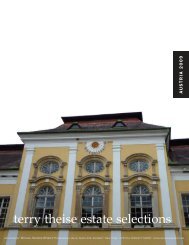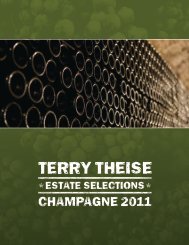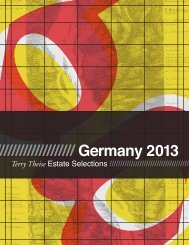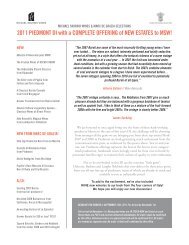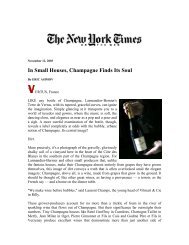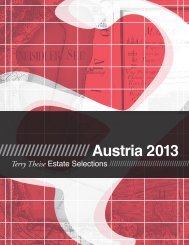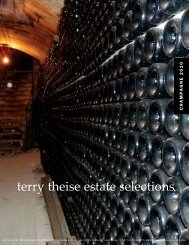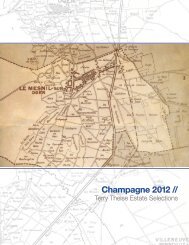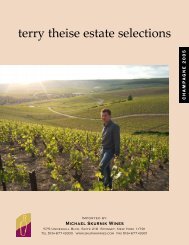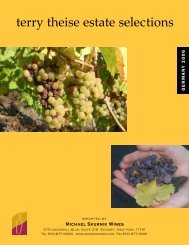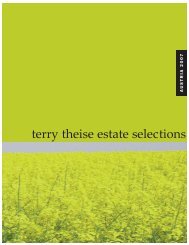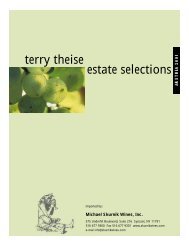View 2013 Champagne Catalog - Michael Skurnik Wines
View 2013 Champagne Catalog - Michael Skurnik Wines
View 2013 Champagne Catalog - Michael Skurnik Wines
You also want an ePaper? Increase the reach of your titles
YUMPU automatically turns print PDFs into web optimized ePapers that Google loves.
Chartogne-Taillet Montagne de Reims // Merfy<br />
vineyard area // 11.5 hectares<br />
annual production // 7,500 cases<br />
villages & soil types // Merfy (sand, clay with chalk and limestone)<br />
grape varieties // 40% Chardonnay, 38% Pinot Noir, 20% Pinot Meunier,<br />
2% Arbanne<br />
Introduction<br />
A few recollections…<br />
Elisabeth Chartogne went far out of her way to help<br />
launch this portfolio in its inception, by being my liaison<br />
on the ground in <strong>Champagne</strong>, and refusing to take any<br />
money for it. Yes it was self-interested, but not directly,<br />
and it couldn’t have happened without her.<br />
At first all I knew was there was a son. Then I learned<br />
he was interested in wine. Then one day, as we sat under a<br />
blossoming early-Spring tree in their garden, schmoozing<br />
with Phillipe Chartogne (and drinking some urgently<br />
needed caffeinated beverages…) I learned that Alexandre<br />
was stage-ing at Selosse. “That’s all I need; now he’s going<br />
to want us to buy three dozen wooden barrels…”<br />
Sometime in those years Elisabeth brought her (then)<br />
young son to meet my wife and me at L’Arnsbourg, a<br />
remote 3-star in the northern Vosges National Park.<br />
I’d been singing its praises to her, that it was stellar and<br />
affordable, and she wanted it to be junior’s first 3-star<br />
meal. Awwww!<br />
So I wasn’t surprised when Alexandre assumed the<br />
estate, and I wasn’t surprised that he was ambitious.<br />
What did surprise me, and continues to surprise me, is<br />
that he is the most passionately curious vigneron I know,<br />
not only in <strong>Champagne</strong>, but just maybe anywhere. He<br />
is pursuing something that doesn’t take the form of<br />
accolades—though these will surely come—and hardly<br />
even asks for answers. It’s a quest for a kind of immersion,<br />
an unquenchable desire to experience.<br />
Please note; to experience, not to “know.” This year<br />
it was just him and me, tasting and talking; we did<br />
dosage trials of several wines, and this takes a person<br />
to the essence of tasting. The more we tasted the more<br />
wonderfully unknowable things seemed to be. Yes, it was<br />
possible to establish where the wines were most delicious<br />
and expressive, and the two of us agreed almost eerily. But<br />
even then, it was impossible to predict what would work,<br />
and each formulation you tried to make was smashed by<br />
the next sequence of wines.<br />
I believe that Alexandre Chartogne is the most<br />
exciting young producer in <strong>Champagne</strong>. And I also<br />
believe he drank from the fountain of wisdom when<br />
he said to me, “I do not feel good when I’m sure about<br />
something.” Because that’s how you measure the hunger<br />
in a man’s soul.<br />
It begins with a new/old approach to vineyard<br />
work, bio-dynam-ish, one might say. Critters (sheeps and<br />
horses), soil analyses of remarkable detail, each aspect of<br />
viticulture challenged and changed as necessary. Cellarwork<br />
is also excitingly new. Indeed there’s almost too<br />
much information to give here. Alexander’s blog is a lovely<br />
source for info and updates, and the estate’s website gives<br />
all the basics. Suffice to say there’s a vivid spirit of inquiry<br />
here, the likes of which I have never seen in this habitriven<br />
region.<br />
Here’s an example. Alexander has installed two<br />
fermentation/storage “eggs” in the cuverie. He had an<br />
exchange last year with Kevin Pike, parts of which I<br />
reproduce (having edited misspellings etc.).<br />
Dear Kevin,<br />
Concerning those eggs, there is a huge vinification<br />
difference between the eggs, the barrels, the vats<br />
(inox or enamel).<br />
- In the barrels, the lees from the fermentations<br />
are moving casually. The winegrower decides<br />
Chartogne-Taillet<br />
Montagne de Reims<br />
Chartogne-Taillet at a glance // 12 hectare estate which occasionally supplements (legally!) with up to 5%<br />
Chardonnay from a friend in Avize. Racy, spicy <strong>Champagne</strong>s at the low end; sumptuous, brioche-y <strong>Champagne</strong>s<br />
at the top.<br />
how the wines taste // Extremely spritzy and highly leesy—one wine made me think of Gimonnet’s Cuvée<br />
Gastronome! At their best they show a force of expressiveness bordering on the supernatural.<br />
43



